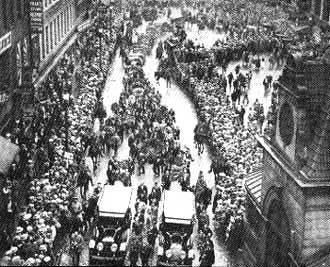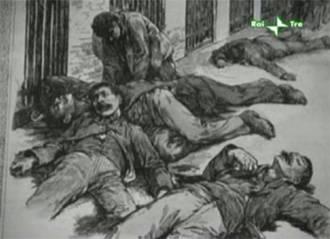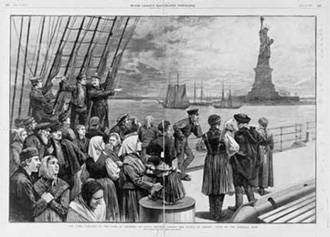'Pane Amaro': The Bitter World of Italian Americans
The Auditorium of the Graduate Center at CUNY was overflowing with people few days ago for the screening of Gianfranco Norelli's “Pane Amaro.” A production of RAI (the Italian public television), the film captures the attention and gazes of at least three generations of Italian Americans present at the screening.
With great documentary precision, the film conjures up salient and often dramatic moments of the Italian/American saga from 1880 until the end of the Second World War. A vast and intense arch of history is carefully organized into a two hour projection presenting rare historical photographs and film segments commented on by experts.
Thanks to his expertise as a reporter, Norelli embarks on a path of ‘dry’ narration, not allowing himself to surrender to sentimentalism and futile rhetoric. He shoots straight with images, film segments and carefully selected and organized testimonials. The result is a contribution dense with moments of reflection as well as information. One may even sense the eagerness of the director to gather as many elements as possible, fully aware of the fact that he is recounting a little known history, which is especially true for the Italian viewing audience.
The Italian/American odyssey, in fact, is still relatively unexplored in Italy – and a vast cultural gap has been created in the past decades between Italians and Italian Americans. True, the same rift is oftentimes found here in the States, due to the difficulty today’s Italian sAmericans encounter when looking back upon their very roots.
But during the screening on this side of the pond, the first questions that came to my mind regarded the Italians in Italy. How many Italians are aware that, between the end of the 19th century and the beginning of the First World War, the victims of the largest mass lynching in United States history were in fact Italians? How many know that in the late 18th century, Italian immigrants ‘replaced’ (for lack of a better word) the emancipated black slaves on the southern plantations and were considered to be a sort of half-breed of people – neither white nor black? Are Italians conscious of the anti-Italian racism that had become widespread amongst the American newspaper columnists during the mass migration period? That inhuman and uncontrollable horde… And how many know about the plight of the Italian immigrant workers, their strikes and struggles, the rise of anarchism, and the complex undertakings of trade-unions amongst Italian men and, significantly, women? Furthermore, what is known about the Italians who were interned during the Second World War, declared by the U.S. government to be enemy aliens?
These are important questions in themselves, but they become even more relevant when one thinks of today’s new waves of immigration – both to America and to Italy. It’s crucial to be aware of the migratory experience that affected so many Italian families during the past century, and this story needs to be told today as new migratory influxes intertwine themselves with the country of immigration, and now Italy too has become a crucial destination for immigrants.
In the film scholars Nunzio Pernicone, Fred Gardaphè, Gerald Meyer, Mary Ann Trasciatti, and Peter Vellon comment on a century and a half of history, following a string of historical episodes. The lynchings, the Triangle Fire tragedy in which 150 workers lost their lives, the assassinations attempts carried out by the anarchists, the Sacco and Vanzetti saga, the Second World War internment camps, the poor living conditions, religion, language, and the quest to Americanize are only but a few of the many topics that are addressed in the documentary. Fiorello La Guardia, Vito Marcantonio, Carlo Tresca, Generoso Pope, and Leonard Covello are among the many names mentioned.
But “Pane Amaro” goes beyond the historic period it recounts. It’s an invitation to understanding for Italians, Italian Americans, and Americans. There was great attention from the audience at the screening and in certain moments there was even a sense of commotion. The high price Italians had to pay to integrate was clearly evident in comments and reflections expressed during the open discussion that developed after the film. And the fact that most of the Italian Americans present only spoke English did have a symbolic meaning. As Norelli recounts in his film, first came the fear to speak their grandparent’s dialects, then the “obligation/order” to speak only American so as not to be recognized as ‘enemies,’ then complete loss of contact with Italy. The renewed interest and the search for their family’s roots is a recent phenomenon for Italian Americans.
Many in the audience took the microphones in their hands to speak and introduced themselves by first and last name, second generation. First and last name, third generation… Today they rediscover the potential of their language looking at the Italian culture with great curiosity.
In 1978 writer Pietro di Donato in his Christ in Concrete, predicted a ‘renaissance’ for Italian-American writers. “Our time is now. I see it because we are no longer figli di muratori (children of construction workers); you go to school and you are children with brains.” His words, together with Gianfranco Norelli’s film, help us reflect thirthy years later.
Further readings:
(Translated by Robert Cavanna)





































i-Italy
Facebook
Google+
This work may not be reproduced, in whole or in part, without prior written permission.
Questo lavoro non può essere riprodotto, in tutto o in parte, senza permesso scritto.